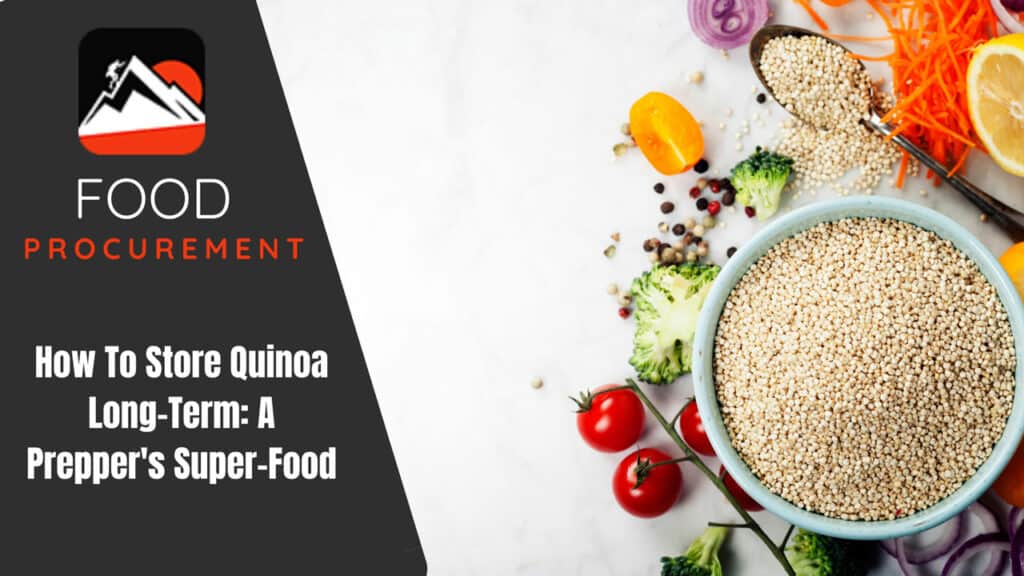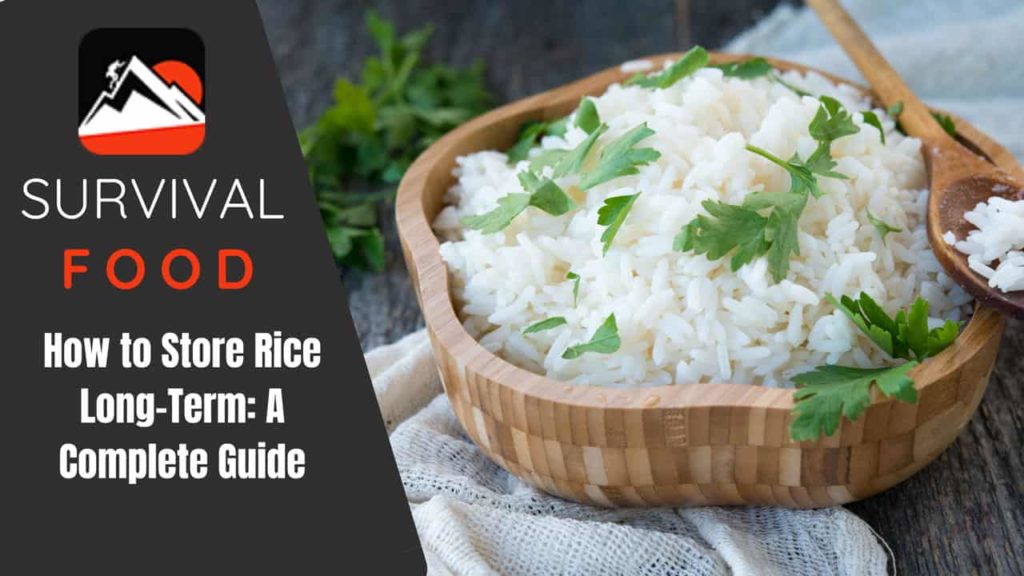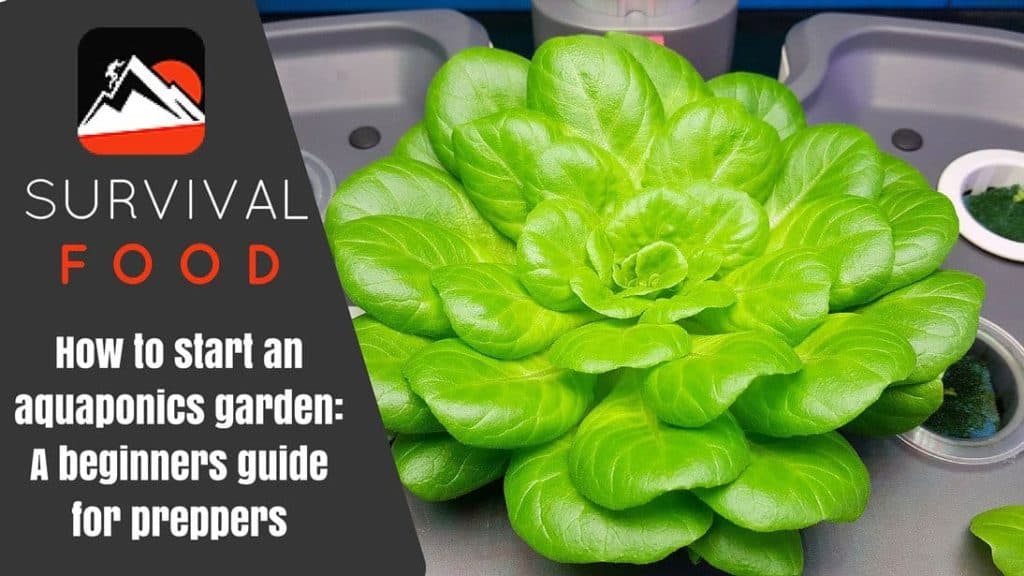Contents
Quinoa is a nutritious seed that originates from South America. It’s become a popular health food in recent years due to its high protein and fiber content. Quinoa is also relatively easy to store long-term, which makes it an excellent option for preppers and survivalists.
Quinoa is a delicious and healthy grain that can be used in all sorts of dishes. However, quinoa doesn’t last forever. In fact, unopened quinoa only has a shelf life of about six months. Once opened, quinoa will only last for about three to four months. So how can you extend the life of your quinoa?
In this blog post, we’ll give you some tips on how to store quinoa so that it stays fresh for years to come.
Key Takeaways
- Dried uncooked quinoa has a shelf life of 2-3 years if kept in a dry cool place
- With proper food storage, quinoa can last up to 20 years
- If you’re looking to store quinoa in bulk, vacuum sealing is the best option.
- You can store raw quinoa in a glass mason jar, but it’s important to make sure it’s airtight.
- If you don’t have a vacuum sealer, you can store quinoa in an airtight food-grade container but not all plastic containers.
- Pests won’t be able to eat quinoa if it’s kept in an airtight container, and germs won’t be able to get into contact with the grains.
- Storing quinoa with an oxygen absorber will help keep it fresh for a longer period of time.
Best Ways to Storing Quinoa Long-Term
Preppers and survivalists know the importance of stocking up on non-perishable food items. Quinoa is a great option because it is high in protein and nutrients. But how do you store quinoa so that it will last for years? Read on to find out the best ways to store uncooked quinoa long-term.
Canning Jars with Oxygen Absorbers
- The main reason canning jars with oxygen absorbers are one of the best ways to store quinoa long-term is because they preserve nutrients. Quinoa is a nutrient-dense food, and it’s essential to ensure that those nutrients are not lost over time. Canning jars with oxygen absorbers help to ensure that the quinoa retains its nutritional value for a longer period.
- Another reason canning jars with oxygen absorbers are one of the best ways to store row quinoa long-term is that they prevent spoilage. When quinoa is exposed to oxygen, it can start to spoil. This process is accelerated when quinoa is exposed to heat or light. Canning jars with oxygen absorbers help to create an airtight seal that prevents oxygen from spoiling the quinoa.
- A final reason canning jars with oxygen absorbers are one of the best ways to store quinoa long-term is because they are space-efficient. When you’re trying to store food fresh long-term, you want to make sure that you’re using food storage containers that will maximize your space. Canning jars with oxygen absorbers help you do just that.
You might also want to read our article about how to store cornmeal long-term.
Vacuum Sealed
Vacuum sealing quinoa is great for long-term storage because it keeps the quinoa fresh for years. That’s because quinoa is a whole grain, and whole grains contain natural oils that can go rancid over time. But when you vacuum seal quinoa, those natural oils are sealed in, keeping quinoa fresh and delicious.
Another benefit of vacuum-sealing quinoa is that it protects the quinoa from insects. Insects are attracted to grains because they can eat them, but when you vacuum seal the quinoa, the insects can’t get to it. So if you’re storing raw quinoa for long periods of time, vacuum sealing it is a great way to keep it fresh and protected from pests.
Mylar Bags with Oxygen Absorbers
Oxygen is one of the biggest enemies of food storage. Oxygen causes food to deteriorate and become rancid. It also promotes the growth of mold and bacteria. By using mylar bags with oxygen absorbers, you can create an airtight environment that will keep fresh for years.
Mylar bags are made from a durable laminate material impervious to light, moisture, and pests. Mylar bags make an excellent food storage solution for dry quinoa and other grains when used in conjunction with oxygen absorbers.
Oxygen absorbers are packets that contain a chemical that absorbs oxygen from the air. By placing an oxygen absorber in each mylar bag, you can remove up to 99% of the oxygen from the bag and create an airtight seal.
Food Grade Containers
Grade food storage containers are made from materials that are FDA-approved for contact with food. This means that they won’t leach chemicals into your food like some other types of containers can.
Additionally, food-grade storage containers are designed to seal tightly, which helps to keep oxygen and moisture out. This is important because oxygen and moisture are two of the main factors that cause food to spoil quickly.
Another benefit of using food-grade storage containers is that they come in various sizes. This means you can find one that’s just right for the amount of food you’re trying to store. And if you’re worried about space, don’t be!
These days, even collapsible grade food storage containers are available on the market.
The surface area of the quinoa flour increases when it is ground, which increases its exposure to air. Due to this, quinoa flour does not last as long as whole quinoa.
We also recommend reading how to store oats long-term.
Why You Should Store Raw Quinoa
Quinoa has been making headlines as a superfood in recent years. Packed with nutrients and complete protein, this grain-like edible seed is an excellent addition to any diet. And for preppers and survivalists, it’s food that can be stored properly long-term and used in many different ways.
Here are just a few of the benefits of storing quinoa.
Packs a Lot of Nutrients, Especially Protein: It’s Considered a Superfood
One of the biggest reasons to add quinoa to your diet is its nutrient density. This little quinoa seed is packed with minerals, vitamins, fiber, naturally gluten free and antioxidants. All nine or eight essential amino acids are present in this plant food, making it a complete protein source. But perhaps most importantly for preppers, quinoa is also protein-rich. In fact, quinoa has way more protein than all other grains. Just one cup of cooked quinoa provides 18 grams of protein. That’s more than double the protein found in rice or couscous.
It Cooks Faster Than Other Grains
Another benefit of quinoa is that it cooks faster than other grains. As a result, prepping and cooking times can be cut in half when using quinoa instead of rice or couscous. This is especially helpful when time is of the essence or when you’re cooking in an emergency situation.
A Good Shelf-Life: Up to 20 Years
When stored properly, quinoa can last up to 20 years—making it an ideal food for preppers and those looking to be prepared for any situation.
Quinoa vs. Rice: Which is Better for Survival?
When it comes to choosing between quinoa and rice, there are pros and cons to each option. Here’s a quick breakdown of the main points:
Quinoa:
- High in protein and fiber content, which can help keep you fuller for longer
- Long shelf life (when properly stored)
- Can be cooked quinoa in less time than rice
- Easier to digest than rice
- More expensive than rice (on average)
- Not as widely available as rice (yet)
Rice:
- Widely available and relatively affordable
- Shelf life is long (when properly stored)
- Easy to cook (just add water)
- Lower in protein and fiber than quinoa, which means you may need to eat more of it to feel satisfied
- Takes longer to cook than quinoa
So, which is better for survival? When it comes to quinoa vs. rice, there is no clear winner. It’s really up to you. Quinoa is a good option if you are looking for an item that is high in protein and fiber but may be more expensive and harder to find.
Rice is a good option
if you are looking for an item that is widely available and easy to cook but has a lower nutritional value. Ultimately, the best decision is the one that works best for you.
Check out the proper way to store rice for emergency survival.
How to Tell if Quinoa Has Gone Bad
Like all food, there comes a time when quinoa goes bad. Here’s how to tell if your quinoa has gone bad and what you can do with it if it has.
- The first thing you’ll want to do is take a look at the quinoa. If it’s discolored or has strange growths, then it’s probably best to throw it out.
- Another sign that quinoa has gone bad is if it smells off—if it smells sour or musty, then it’s time to say goodbye.
- Finally, if the quinoa is harder or softer than usual, or if the texture is otherwise off, then it’s probably past its prime.
If your quinoa does happen to go bad, there are still some uses for it. For example, you can cook it and use it as fertilizer for your plants. You can also use it as mulch around sensitive plants. Just be sure to use gloves when handling bad quinoa, as it can cause stomach upset.
How to Cook Quinoa the Right Way
Cooking quinoa correctly is crucial; it can be very dry and unpalatable if you don’t cook it right.
- Step One: Rinse the quinoa in a fine-mesh strainer. This step is essential; it removes the bitter outer coating from the quinoa grains, making them much more palatable. Be sure to give the quinoa a good rinse; if any bits of coating are left on the grain, your quinoa will be bitter.
- Step Two: Add the rinsed quinoa to a pot with twice as much water as the grain. Bring the water to a boil, then reduce the heat and simmer for about 15 minutes, or or until the cooked quinoa is tender.
- Step Three: Having cooked quinoa, fluff it with a fork and add your desired seasonings. Quinoa goes well with just about anything, so get creative! For example, try adding some chopped vegetables and a vinaigrette for a light and healthy salad, or stir in some beans and salsa for a hearty and filling main dish.
There you have it—now you know how to cook quinoa the right way! With this simple three-step method, you’ll be able to enjoy delicious and nutritious quinoa as part of your prepper food stockpile.
FAQ
Can you freeze cooked quinoa?
Yes, after it has been cooked, you can freeze it! The temperature must remain below 5oC (41oF). It can potentially last longer if it is stored in the freezer.
If the grains are in poorly packed frozen food, freezing can result in faster degradation. Poorly packaged frozen quinoa loses moisture due to oxygen at temperatures below freezing, affecting texture and taste. We call this effect freezer burn.
How Long Will Quinoa Keep In The Refrigerator?
When store cooked quinoa, can last 6-7 days in the fridge, but but freeze uncooked quinoa can last even longer.
Conclusion
With these tips, you can easily store raw quinoa long-term without worrying about it going bad. Just be sure to purchase high-quality seeds, clean them thoroughly, air dry them completely, and then store them in an airtight container in a cool, dark place. By following these simple steps, you can enjoy fresh quinoa anytime you like – even if the SHTF!





